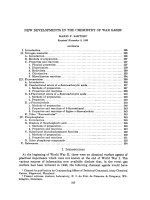Country Profile: Vietnam, new ICOLD member - THE DAMS NEWSLETTER ppsx
Bạn đang xem bản rút gọn của tài liệu. Xem và tải ngay bản đầy đủ của tài liệu tại đây (852.08 KB, 5 trang )
No. 6 - February 2007
ICOLD on the front line for development
CIGB
ICOLD
CIGB
ICOLD
CIGB
ICOLD
CIGB
ICOLD
Focus - Country profi le : Vietnam, new ICOLD member p. 2 Dams in the World Press - World Water Council Director: Dams are necessary
to solve «chronic water scarcity» p. 6 News from ICOLD - New life for IWALC p. 7 News from ICOLD - World in danger of missing
sanitation target; drinking-water target also at risk, new report shows p. 9 News from National Committees - Burkina Faso: First National
Congress on Dams p. 11 Diary p. 12
in this issue
in this issue
THE DAMS
N
EWSLETTER
THE DAMS
N
EWSLETTER
Luis Berga
President, ICOLD
Michel De Vivo
Secretary General, ICOLD
A
t the beginning of 2007 only eight years remain to face up to the challenges that
humanity has established in the Millennium Development Goals (MDGs) to be
achieved by 2015. Different international reports indicate that great efforts are being
made to improve access to drinking water and basic sanitation, but these efforts are
still not suffi cient, and there are regions in the world, mainly in Sub-Saharan Africa,
where all types of actions have to be taken urgently.
The case of Africa is well known. Seventy per cent of the population lives in darkness,
with obvious consequences: No Light, No Clean Water, No Health Care, and No
Education. This situation continues while less than 7% of the hydroelectric potential is
exploited in the continent. And Africa is only the most extreme case of a world hungry
for clean renewable power.
Solving the world’s water and electricity problems is a multi-faceted issue, and it
must be tackled within the framework of the Integrated Water Resources and Energy
Management. All kinds of potentially viable actions must be urgently applied, and
experience has shown that dams and reservoirs (large, medium-sized and small) are a very
effective and effi cient option on many occasions, on the understanding that they must
be constructed and operated in an environmentally sustainable and socially equitable
way. Dams bring development and well-being for hundreds of millions of people.
It is therefore the duty and mission of ICOLD to promote and develop dams and
hydropower in the developing world, Africa being the priority. ICOLD and its 85
National Committees represent great human potential, with more than 10,000
professionals and experts in the fi eld of dams. There are also 24 Technical Committees,
in which approximately 400 experts participate, responsible for disseminating State
of the Art reviews on technical, economic, social and environmental matters as
pertaining to dams. Therefore, ICOLD is available to all the international organisations,
governments and other civil authorities, to help achieve the sustainable development
targets.
ICOLD also has to make alliances in order to accomplish that mission. That is why we
are striving to give new impetus to IWALC, and we are actively looking for cooperation
with United Nations organisations. On the public relations front, our new website is
fi nally online and we hope it will serve as a tool to accomplish ICOLD’s mission.
Michel de Vivo Luis Berga
ICOLD Secretary General ICOLD President
Country Profile: Vietnam, new ICOLD member
tHE dAMS nEWSLETTER - no. 6 - FEBRUARY 2007PAGE 2
T
he country is approximately 331 688 square km (128,066 sq mi) in area, which is
slightly smaller than Germany. The topography consists of hills and densely forested
mountains, with level land covering no more than 20 percent. Mountains account for
40 percent, hills 40 percent and forests 42 percent. The northern part of the country
consists mostly of highlands and the Red River Delta. Phan Xi Păng, located in Lào
Cai province, is the highest mountain in Vietnam at 3143m (10,312 ft). The south is
split into coastal lowlands, Annamite Chain (central mountains) with high plateaus,
and the Mekong River Delta. Mountains 500 m and more high occupy a third of the
land. The highest mountain is Fansipan, at 3143m.
The climate is tropical and monsoonal; humidity averages 84 percent throughout the
year. Annual rainfall ranges from 120 to 300 cm (47 to 118 in), and annual temperatures
vary between 5°C (41°F) and 37°C (99°F).
There are 18 600 km² (1993 est.) of irrigated land in the country, out of 325 360 km²
of land area, 55 250 km² of which is arable.
As a result of several land reform measures, Vietnam is now the largest producer of
cashew nuts with a one-third global share and second-largest rice exporter in the
world. Besides rice, key exports are coffee, tea, rubber, and fi shery products. However,
agriculture’s share of economic output has declined, falling as a proportion of GDP
from 42% in 1989 to 26% in 1999, as production in other sectors of the economy
has risen. Tourism has become an increasingly important industry in Vietnam. There
are over 3 to 3.5 million annual visitors.
V
ietnam is one of the two
newest members in ICOLD.
We present here a few facts about
this country and its hydroelectric
resources and potential.
Country Profi le :
Vietnam, new ICOLD member
Focus
FOCUS
tHE dAMS nEWSLETTER - no. 6 - FEBRUARY 2007 PAGE 3
Economy
In 1986, the Sixth Party Congress of the Communist Party of Vietnam formally aban-
doned its centralized planned economy and began introducing market elements as part
of a broad economic reform package called «đổi mới» («Renovation»).
In many ways, this followed the Chinese model and achieved similar results. On one
hand, Vietnam achieved around 8% annual GDP growth from 1990 to 1997 and
continued at around 7% from 2000 to 2002, making it the world’s second-fastest
growing economy. Simultaneously, investment grew three-fold and domestic savings
quintupled.
On the other hand, urban unemployment has been rising steadily in recent years due to
high numbers of migrants from the countryside to the cities, and rural unemployment,
estimated to be up to 35% during non-harvest periods, is already at critical levels.
Layoffs in the state sector and foreign-invested enterprises combined with the lasting
effects of a previous military demobilization further exacerbated the unemployment
situation. The country aims to become a member of the WTO, perhaps as soon as
October 2006. In May 2006, Vietnam negotiated a bilateral trade agreement with the
US that marked the completion of the bilateral negotiations with WTO members the
country needed to qualify for accession to the organization. Among other steps taken
in the process of transitioning to a market economy, Vietnam in July 2006 updated
its intellectual property legislation to comply with TRIPS.
Vietnam is still a relatively poor country with a GDP of US$70 billion (2006 estimate).
This translates to approximately US$820 per capita. Infl ation is estimated at 14% per
year in 2004.
Electricity
Although Vietnam’s per capita electricity consumption is among the lowest in Asia,
demand has risen in recent years, straining the country’s limited generating capacity.
Rapid commercial sector growth, population migration to major cities, and elevated
living standards have all contributed to a growing demand for electricity. In 2002,
Vietnam had a total electricity generating capacity of 8.3 gigawatts (GW) and generated
34.5 billion kilowatthours (kWh) of electricity, of which 60% was hydropower. This
share is expected to decrease in
the future, despite the building
of new hydroelectric dams,
because of a number of new
fossil fuelled power plants.
The rural electrifi cation program
has been accelerated. The fi rst
Rural Energy project brought
electricity to approximately
500 000 households from
2001 to the end of 2004. A
$220 million World Bank loan
for the project is designed to
bring power to 2.5 million
households According to the
Vietnamese government, village
electrifi cation will reach 80% in
2010 (the fi gure is now slightly
above 50%). Similarly, 90% of
the total Vietnamese population
is expected to be connected to
the grid in 2010 (now 87%).
tHE dAMS nEWSLETTER - no. 6 - FEBRUARY 2007PAGE 4
With the growing industrial demand, electricity demand in Vietnam is forecast to grow
15%-16% per year until 2010. Vietnam currently buys power from China to prevent
shortages in the North, and plans to begin purchasing from Laos in 2008.
In January 2005, EVN announced its intention to increase electricity production by
20% within the year and to increase generating capacity to 11 400 MW in 2005 (and
17 500 by 2010).
Vietnam currently has fi ve hydroelectric developments underway. The country’s Son
La project, anticipated to have a generating capacity of 2400 MW by 2012, will be
the largest hydroelectric project in Vietnam when completed. In September 2004,
construction began on the Ban Ve hydroelectric power plant, expected to begin
operations in 2008. EVN began work on four additional hydroelectric projects in late
2004. The Dong Nai 3 and Dong Nai 4, both located in the Central Highlands region,
are expected to be completed within four years and to provide approximately 520
MW generating capacity. In December 2004, EVN began construction of the Se San
4 hydropower plant in the Central Highlands provinces of Gia Lai and Kon Tum. The
plant is anticipated to have a capacity of 330 MW and to generate 1,390 million kWh
per year. Vietnam also plans to build three additional plants in the region by 2010.
In March 2004, the Vietnamese government approved construction of the 2.4 GW Son
La hydroelectric project, which began late 2005. One third of the $2.3 billion invest-
ment has been earmarked for the resettlement of families living in the 44 700 hectares
to be fl ooded by the reservoir. The plant is expected to be operational by 2015.
Lastly Vietnam plans to complete its fi rst nuclear power plant by 2020 as an alternative
means of meeting demand. In December 2004, the Vietnamese Ministry of Science
and Technology submitted a pre-feasibility study for the 2000-MW nuclear plant to
the National Assembly.
Dams in Vietnam
Vietnam has a historical tradition in water engineering. Old earth dyke systems in the
Red river basin have been built in the North since the 12
th
Century. The fi rst big channels
were dug in the Mekong delta in the South 300 years ago. Some large irrigation systems
consisting of weirs, canals and sluices were built in the 1920s and 1930s. More than
2500 pools (each has a storage capacity of less than 5 million m
3
) and 500 reservoirs
have been built. Since 1990, on the lower Da river in the North-West (70 km from
Hanoi), there has come into operation a big Hoa Binh reservoir with 9.5 billion m
3
capacity (V) and a rockfi ll dam 128m high with 1920 MW installed capacity. Now a
bigger scheme is under construction upstream (it is planned to operate the 1
st
turbine
in 2009) with a storage capacity of 12.5 billion m
3
and a roller compacted concrete
dam 139 m high (H) rated at 2400 MW.
tHE dAMS nEWSLETTER - no. 6 - FEBRUARY 2007 PAGE 5
In Vietnam the highest earthfi ll dam is 60m, clay core-wall rockfi ll (CCR) dams
are H=54÷128m, concrete face rockfill (CFR) dams are 70÷119m, traditional
gravity concrete dams are H=15÷46 m, roller compacted concrete (RCC) dams are
H=53÷139m. Beside common technical demands, dam construction calls for much
special engineering research work such as fl ood frequency design, optimum combination
of locally available materials, dam and spillway sizes, river diversion versus peak fl ood,
dam material processing, in the light of natural conditions.
Reservoirs fall into two categories, reservoirs designed specifi cally for energy production,
and multipurpose reservoirs which must comply with strict rules regarding operation
for fl ood mitigation, water supply, irrigation and power generation. Today, there are
three ambitious ten-year National Programs in operation (2005-2015) with more than
US$10 billion investment:
• Program for Medium and Small Water Systems in dispersed areas in highlands and
mountains aiming at local water demand satisfaction and poverty reduction;
• Program for Large Multipurpose Water Systems with big reservoirs
(V=0.3÷1.5 billion m
3
) and high dams (H=50 ÷115m);
• Program for Large Hydro Power Plants with high power capacity
(P=150÷2400 MW).
Hydroelectric Potential
Already Exploited: 18 000 millions kWh
Economically feasible: 52 millions kWh
Technically feasible: 72 millions kWh
Theoretical: 309 millions kWh
The economically and technically feasible fi gures have
been recently revised downward due to environmental
constraints (displacement of populations).
Today’s hydroelectric dams are relatively new (see tables).
There are 10 multipurpose dams, either earthen dams or
rockfi ll dams. Their operational problems are mainly due
to their multipurpose nature: it is diffi cult to optimize
operation when faced with conflicting priorities:
fl ood protection, maximizing electricity production,
conservation of water resources for the down stream
regions, etc. There are also more specifi c problems with
silting, due to erosion in the catchment area subjected
to violent rains and deforestation. The reservoir capacity
is reduced, which threatens the fl ood protection role.
Lastly, small and old dams are insuffi ciently maintained,
due to lack of money.
A promising future
Electricity of Vietnam public utility has submitted a very ambitious plan to build
45 dams for hydroelectricity in the next twenty years. Among them, the biggest is the
Son La Project. With 2400 MW (10 generators) installed capacity, it is expected to
produce 9000 MWh. (See tables). According to the announced fi gures, Vietnamese
hydroelectric capacity will increase by 5080 MW by 2010 and 7220 MW by 2020.
This would represent a large fraction of the 10 000 MW yearly world market (5% and
7% respectively). Some have questioned the capacity of Vietnam to accomplish this
ambitious plan, and expect that gas fi red power stations would benefi t much more from
increased demand, because they are more easily fi nanced through BOT-type schemes
and because Vietnam is quite rich in gas resources.









